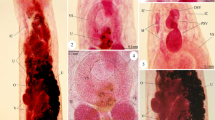Abstract
In the present study, from August 2015 to July 2016, a total of 159 specimens of Wallago attu Bloch and Scheider, 1801 vern. mully were collected from the Ropar wetland, Punjab, India and were examined for the presence of intestinal tapeworms. The infection rate was 12.5%, out of which, two fishes were heavily infected with a proteocephalidean cestode belonging to the genus Gangesia in the month of February. Gangesia punjabensis sp. nov. was identified and described on the basis of morphology and partial amplification of LSUrDNA (28S rDNA). The histopathogenesis caused by these parasites have also been studied in histological sections. About 9–35 number of worms were collected from a single host. The length of worms ranged from 6.0 to 6.2 cm. The strobila consisted of an armed scolex, neck, immature proglottids (approximately 90 in number) and mature proglottids (approximately 7 in number) and gravid proglottids were not detected. Analysis of 28S large subunit (LSU) rDNA sequence of the isolate of G. punjabensis n. sp. demonstrated maximum similarity of 99% with G. bengalensis, 98% with G. vachai, 97% with G. macrones. The phylogenetic tree based on the final edited alignment (822 bp) with Neighbour-Joining showed the highest bootstrap value of 100 and placed G. punjabensis n. sp. with G. bengalensis and G. macrones in the same clade showing them to be a species complex. The intestinal mucosal lining exhibited blister formation, haemorrhagia and inflammation due to the presence of deeply embedded scolices. Histopathology caused was evident due to disruption of villous surface and cellular infiltration. This is the first report of cestodes belonging to the genus Gangesia from Ropar wetland, Punjab, India.






Similar content being viewed by others
References
Ash A, Scholz T, Dechambrier A, Brabec J, Oros M, Kar PK, Chavan SP, Mariaux J (2012) Revision of Gangesia (Cestoda: Proteocephalidea) in the Indomalayan Region: Morphology, molecular and surface ultrastructure. Plos ONE 7(10):e46421
Chervy L (2009) Unified terminology for cestode microtriches: a proposal from the international workshops on cestode systematic in 2002–2008. Folia Parasitol 56:199–230
Gupta V, Parmar S (1988) On a new species Silurotaenia vachai sp. nov. (Family: Proteocephalidae La Rue, 1911) from a fresh water fish Eutropiichthys vacha from Lucknow. Indian J Helminthol 40(1):27–31
Hafeezullah M (1993) Caryophyllidean cestode fauna of India. Rec. Zool. Surv. India, Occasional paper no. 157, pp 101
Haque M, Siddiqe AH (1978) Histopathology of pig and man. Indian J Parasitol 2(2):97–98
Hiware CJ (2008) Studies on histopathology of Clariasbatrachus (Linnaeus) intestine parasited by cestode, Lytocesus clariasae Jadhav and Gahvane, 1991. J Yala Rajabhat Univ 2:10–12
Jadhav BV, Bhure DB, Padwal N, Nanaware SS (2010) Survey of tapeworm from Aurangabad region. Rec. Zool. Survey India: J. Indian 110(Part-1):107–114
Kimura M (1980) A simple method for estimating evolutionary rate of base substitutions through comparative studies of nucleotide sequence. J Mol Evol 16:111–120
Oros M, Scholz T, Hanzelová V, Mackiewicz JS (2010) Scolex morphology of monozoic cestodes (Caryophyllidea) from the Palaearctic Region: a useful tool for species identification. Folia Parasitol 57:37–46
Sambrook J, Russell DW (2001) Molecular cloning: a laboratory manual. Cold Spring Harbor Laboratory Press, Cold Spring Harbor
Scholz T, Drábek R, Hanzelová V (1998) Scolex morphology of Proteocephalus tapeworms (Cestoda: Proteocephalidae), parasites of freshwater fish in the Palaearctic Region. Folia Parasitol 45:27–43
Southwell T (1913) On some Indian Cestoda (part 1). Rec Indian Mus 9:279–300
Talwar PK, Jhingran AG (1991) Inland fishes of India and adjacent countries, vol 2. Oxford and IBH Publishing Co., Pvt Ltd, New Delhi, p 1158
Tamura K, Peterson D, Peterson N, Stecher G, Nei M, Kumar S (2013) MEGA6 molecular evolutionary genetics analysis using maximum likelihood, evolutionary distance and maximum parsimony methods. Mol Biol Evol 28:2731–2739
Verma SC (1928) Some cestodes from Indian fishes, including four new species of Tetraphyllidea and revised keys to the genera Acanthobothrium and Gangesia. Allahabad Univ Stud 4:119–176
Woodland WNF (1924) On a new Bothriocephalus and a new genus of Proteocephalidae from Indian fresh-water fishes. Parasitology 16:441–451
Yamaguti S (1959) Systema Helminthum. Vol II. The cestodes of vertebrates. Interscience Publishers Inc., New York
Acknowledgements
The authors acknowledge financial support by University Grants Commission (UGC), Govt. of India under CAS-II and DST purse grants to the Department of Zoology, Panjab University, Chandigarh.
Author information
Authors and Affiliations
Corresponding author
Ethics declarations
Conflict of interest
There is no conflict of interest to disclose.
Rights and permissions
About this article
Cite this article
Jasrotia, D., Kaur, H. Molecular analysis of a novel species, Gangesia punjabensis (Family: Proteocephalidae, Subfamily: Gangesiinae) infecting an Indian freshwater cat fish, Wallago attu evidencing species complex. J Parasit Dis 41, 888–898 (2017). https://doi.org/10.1007/s12639-017-0912-8
Received:
Accepted:
Published:
Issue Date:
DOI: https://doi.org/10.1007/s12639-017-0912-8




